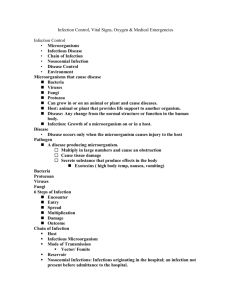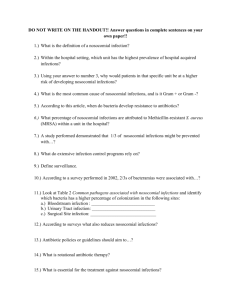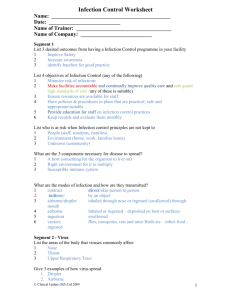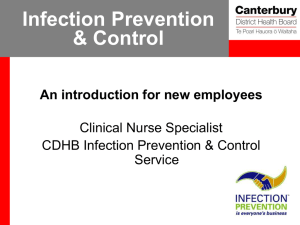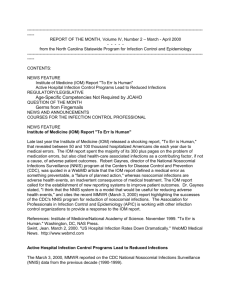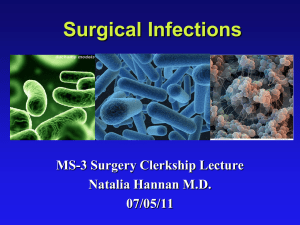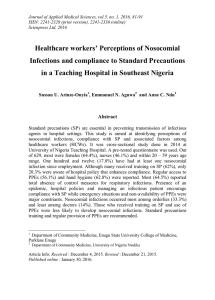Chapter 12 Supplement
advertisement
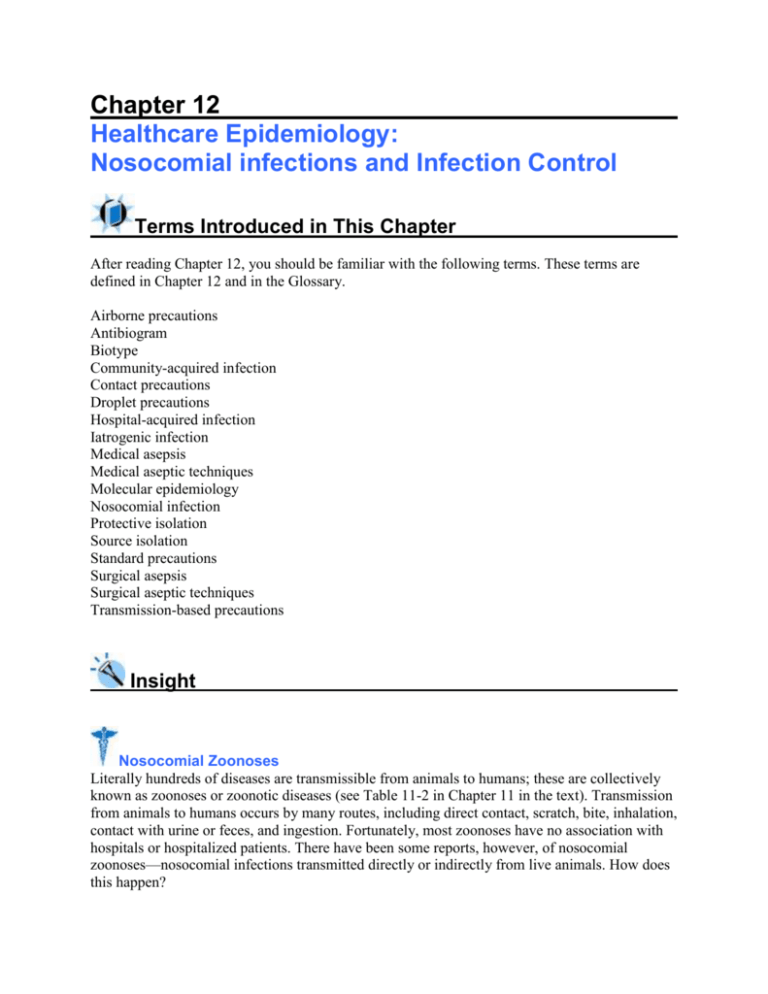
Chapter 12 Healthcare Epidemiology: Nosocomial infections and Infection Control Terms Introduced in This Chapter After reading Chapter 12, you should be familiar with the following terms. These terms are defined in Chapter 12 and in the Glossary. Airborne precautions Antibiogram Biotype Community-acquired infection Contact precautions Droplet precautions Hospital-acquired infection Iatrogenic infection Medical asepsis Medical aseptic techniques Molecular epidemiology Nosocomial infection Protective isolation Source isolation Standard precautions Surgical asepsis Surgical aseptic techniques Transmission-based precautions Insight Nosocomial Zoonoses Literally hundreds of diseases are transmissible from animals to humans; these are collectively known as zoonoses or zoonotic diseases (see Table 11-2 in Chapter 11 in the text). Transmission from animals to humans occurs by many routes, including direct contact, scratch, bite, inhalation, contact with urine or feces, and ingestion. Fortunately, most zoonoses have no association with hospitals or hospitalized patients. There have been some reports, however, of nosocomial zoonoses—nosocomial infections transmitted directly or indirectly from live animals. How does this happen? Wild rodents such as rats and mice might enter hospitals where they can transmit diseases such as leptospirosis, rat-bite fever, and rickettsial pox. Droppings from wild birds can enter air vents and air-conditioning systems, causing diseases such as histoplasmosis and cryptococcosis. Pathogens from laboratory animals could enter air ventilation systems and be conveyed to patient care facilities. Pet therapy is becoming increasingly popular in nursing homes, where pets provide companionship for the residents. Such pets can be the source of pathogens. If animal tissues and organs are used for transplantation, there is always the danger of undetected microorganisms and other infectious agents (e.g., viruses and prions) being present in the transplanted material. Healthcare professionals can also be the source of zoonotic pathogens, especially those who have domestic pets or farm animals where they live. Should these workers wear their uniforms while playing with or caring for their animals, the uniforms could be contaminated with zoonotic pathogens. Or, if they should fail to wash their hands after touching their animals, pathogens could be carried from home to hospital on their hands. Pathogens that could potentially cause nosocomial zoonoses include cutaneous fungi (such as Microsporum canis and others that cause ringworm infections); bacteria such as staphylococci, streptococci, Pseudomonas, Salmonella, and Campylobacter; yeasts; and parasites such as Cryptosporidium. Several outbreaks in intensive care nurseries have resulted from Malassezia furfur and Malassezia pachydermatis, fungi that were transmitted from pets to lowbirth-weight neonates via the hands and clothing of healthcare professionals. Prevention of nosocomial zoonoses involves keeping medical facilities free of rodents, preventing birds from nesting near air-conditioners and air vents, and ensuring that laboratory animal ventilation systems are not linked to ventilation systems in patient care areas. In addition, laboratory coats worn in animal facilities should never be worn in patient care areas, and hospital uniforms should not be worn to and from work. Animals used in pet therapy should be vaccinated and in good health. And the most important way to prevent nosocomial infections of any kind is frequent and proper handwashing. Healthcare professionals must always wash their hands after handling animals and before providing patient care. Infection Control Professionals Individuals wishing to combine their interest in detective work with a career in medicine might consider a career as an infection control professional (ICP). ICPs include physicians (infectious disease specialists or epidemiologists), nurses, clinical laboratory scientists (medical technologists), and microbiologists. Most ICPs are nurses, many having baccalaureate degrees and some with master’s degrees. In addition to having strong clinical skills, ICPs require knowledge and expertise in such areas as epidemiology, microbiology, infectious disease processes, statistics, and computers. To be effective, they must be part detective, part diplomat, part administrator, and part educator. In addition, ICPs function as role models, patient advocates, and consultants. Within the hospital, ICPs provide valuable services that minimize the risks of infection and spread of disease, thereby aiding patients, healthcare professionals, and visitors. The ICP is the key person in implementing and facilitating the institution’s infection control program. The ICP is often the head of the hospital’s Infection Control Committee (ICC) and, as such, is responsible for scheduling, organizing, and conducting ICC meetings. At these meetings, medical records are reviewed of all patients suspected of having incurred a nosocomial infection since the previous meeting. The committee discusses possible or known causes of such infections and ways to prevent them from occurring in the future. The ICP receives timely information from the clinical microbiology laboratory concerning possible outbreaks of infection within the hospital, and is responsible for rapidly organizing a team to investigate these outbreaks. ICPs are also responsible for educating healthcare personnel about infection risk, prevention, and control. Increase Your Knowledge 1. Information about the Society for Healthcare Epidemiology of American (SHEA) can be found at their web site: www.shea-online.org 2. Information about Infection Control Professionals/Practitioners can be found at www.apic.org, the web site for the Association for Professionals in Infection Control and Epidemiology. 3. Additional information about handwashing (or the lack thereof) can be found at www.washup.org Critical Thinking 1. As a clinical laboratory scientist, you have been processing environmental specimens that were collected as part of an investigation into a Pseudomonas aeruginosa outbreak that is occurring on the pediatric ward. You’ve isolated P. aeruginosa from a sample of water from a mop bucket on the pediatric ward. How would you go about proving that the P. aeruginosa from the mop bucket is the same strain of P. aeruginosa that caused the outbreak, and, therefore, that the contaminated mop bucket water is the probable source of the epidemic? 2. A patient who has been hospitalized for several weeks as a result of pneumonia has just developed pseudomembranous colitis (PMC). What do you think caused this condition? Do you think that her PMC should be considered a nosocomial infection? Do you think that her PMC should be considered an iatrogenic infection? Answers to the Chapter 12 Self-Assessment Exercises in the Text 1. 2. A D 3. 4. 5. 6. 7. 8. 9. 10. B B B B A D A D Additional Chapter 12 Self-Assessment Exercises (Note: Don’t peek at the answers before you attempt to solve these self-assessment exercises.) Matching Questions A. B. C. D. E. arthropodborne infections community-acquired infections iatrogenic infections nosocomial infections nosocomial zoonoses _____ 1. Infections that patients develop while hospitalized or within 14 days of hospital discharge are considered to be _______________. _____ 2. Infections that patients have on hospital admission are considered to be _______________. _____ 3. _______________ may result if healthcare workers fail to wash their hands after handling laboratory animals or pets being used for pet therapy. _____ 4. Infections that are actually caused by healthcare workers are specifically known as _______________. _____ 5. Each year, in the United States, approximately 2 million hospitalized patients develop _______________. A. B. C. D. E. Airborne precautions Contact precautions Droplet precautions Medical aseptic technique Surgical aseptic technique _____ 6. In addition to Standard precautions, _______________ must be used when managing a patient with streptococcal pneumonia. _____ 7. The goal of _______________ is to render and keep objects and areas sterile. _____ 8. In addition to Standard precautions, _______________ must be used when managing a tuberculosis patient. _____ 9. The goal of _______________ is to reduce the number and transmission of pathogens. _____ 10. In addition to Standard precautions, _______________ must be used when managing a patient with a Clostridium difficile–associated disease. True/False Questions _____ 1. Most of the pathogens involved in nosocomial infections come from the patients themselves. _____ 2. An infection that results from urinary catheterization would be considered an iatrogenic infection. _____ 3. Bacteria are the only pathogens that have become drug resistant. _____ 4. A patient with tuberculosis should be placed in protective isolation. _____ 5. A superinfection with Clostridium difficile could lead to diseases such as antibiotic-associated diarrhea and pseudomembranous colitis. _____ 6. One of the major factors contributing to nosocomial infections is the failure of healthcare personnel to follow infection control guidelines. _____ 7. Joseph Lister is considered the “Father of Handwashing.” _____ 8. A leukopenic patient should be placed in a patient room having positive air pressure. _____ 9. Members of a hospital’s Infection Control Committee would investigate outbreaks and epidemics that occur within that hospital. _____ 10. By practicing Standard precautions, healthcare workers will be protected from becoming infected, regardless of the type of infectious disease that the patient has. Answers to the Additional Chapter 12 Self-Assessment Exercises Matching Questions 1. 2. 3. 4. 5. 6. 7. 8. 9. 10. D B E C D C E A D B True/False Questions 1. 2. 3. 4. 5. 6. 7. 8. 9. 10. True True False (certain viruses, fungi, and parasitic protozoa have also become drug resistant) False (a patient with tuberculosis should be placed in source isolation) True True False (Ignaz Semmelweis is considered the “Father of Handwashing”) True True False (for certain types of diseases, transmission-based precautions must also be practiced)
